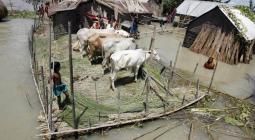Everything politicians tell you about immigration is wrong. This is how it actually works
Escaping poverty, violence and the climate crisis are factors, but the main driver is rich societies demanding cheap labour
We seem to be living in times of unprecedented mass migration. Images of people from Africa crammed into unseaworthy boats desperately trying to cross the Mediterranean, asylum seekers crossing the Channel into Britain, and “caravans” of migrants trying to reach the Mexico-US border all seem to confirm fears that global migration is spinning out of control.
A toxic combination of poverty, inequality, violence, oppression, climate breakdown and population growth appear to be pushing growing numbers of people from Africa, Asia and Latin America to embark upon desperate journeys to reach the shores of the wealthy west.
All of this results in the popular idea of a “migration crisis” that will require drastic countermeasures to prevent massive waves of people arriving in the future, apparently exceeding the absorption capacity of western societies and economies.
Despite this, however, there is no scientific evidence to sustain the claim that global migration is accelerating. International migrants account for about 3% of the world population, and this percentage has remained remarkably stable over the past half a century.
Likewise, refugee migration is much more limited than political rhetoric and media images suggest. About 10% of all international migrants are refugees, representing 0.3% of the world population. While refugee flows fluctuate strongly with levels of conflict, there is no evidence of a long-term increasing trend. About 80-85% of refugees remain in regions of origin, and that share has also remained rather stable over the past decades. And there is no evidence that illegal migration is spinning out of control – in fact, the large majority of migrants who move from the global south to the global north continue to move legally. For instance, nine out of 10 Africans move to Europe legally, with passports and papers in hand.
The evidence also turns common understandings of the causes of migration on its head. The conventional view is that south-to-north migration is in essence the outgrowth of poverty, inequality and violence in origin countries – hence the popular idea that poverty reduction and development are the only long-term solutions to migration.
However, this assumption is undermined by evidence showing that migration rises as poor countries become richer. This is because increasing levels of income and education, alongside infrastructure improvements, raise people’s capabilities and aspirations to migrate. Instead of the stereotypical “desperate flight from misery”, in reality migration is generally an investment in the long-term wellbeing of families and requires significant resources. Poverty actually deprives people of the resources required to move over long distances, let alone to cross continents.
This is also one of the many reasons why, contrary to common assumptions, climate breakdown is unlikely to trigger mass movements of “climate refugees”. Research on the effects of droughts and flooding shows that most people will stay close to home. In fact, the most vulnerable people are most likely to get trapped, unable to move out at all.
It is no coincidence that most migrants come from middle-income countries such as India and Mexico. The paradox is that any form of development in the poorest countries of the world – such as in sub-Saharan Africa – is therefore likely to increase their future emigration potential.
Still, despite global averages remaining stable, it is difficult to deny that legal immigration to the US, Britain and western Europe has been growing over the past decades. The frequent discontent this has caused has gone along with repeated calls for less, more controlled or more selective immigration.
But border crackdowns have clearly failed to achieve these objectives or have even made problems worse because they were not based on an understanding of how migration really works. The main reason is that these policies ignored the most important root cause of migration: persistent labour demand.
The misleading assertion that poverty causes migration conceals the fact that labour demand has been the main driver of growing immigration to western countries since the 1990s. More widespread education, women’s emancipation and population ageing have led to labour shortages; these have fuelled a growing demand for migrant workers in sectors such as agriculture, construction, cleaning, hospitality, transport and food processing, as supplies of local workers willing and able to do such jobs have increasingly run dry. Without such chronic labour shortages, most migrants wouldn’t have come.
But this hasn’t been a natural process. It is instead one that has been encouraged by decades of policies geared towards economic and labour market liberalisation, which have fuelled the growth of precarious jobs that local workers won’t take. Politicians from left to right know this reality, but they don’t dare admit it out of fear of being seen as “soft on immigration”. They choose instead to talk tough and revert to acts of political showmanship that create an appearance of control, but that in effect function as a smokescreen to conceal the true nature of immigration policy. Under this current arrangement, more and more migrants are allowed in, and the employment of undocumented workers is widely tolerated as they fill in crucial labour shortages.
Politicians have turned a blind eye as proven by almost laughably low levels of workplace enforcement.
To break away from this legacy of failed policies, politicians need to gather the courage to tell an honest story about migration: that it is a phenomenon that benefits some people more than others; that it can have downsides for some, but cannot be thought or wished away; and that there are no simple solutions for complex problems.
Fundamental choices have to be made. For example, do we want to live in a society in which more and more work – transport, construction, cleaning, care of elderly people and children, food provision – is outsourced to a new class of servants made up mainly of migrant workers? Do we want a large agricultural sector that partly relies on subsidies and is dependent on migrants for the necessary labour? The present reality shows that we cannot divorce debates about immigration from broader debates about inequality, labour, social justice and, most importantly, the kind of society we want to live in.
- Hein de Haas is professor of sociology at the University of Amsterdam, and the author of How Migration Really Works
Cover photo: Illustration: Eleanor Shakespeare






